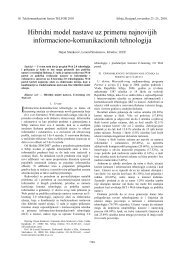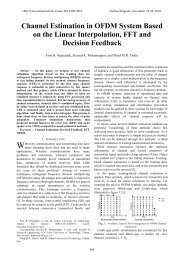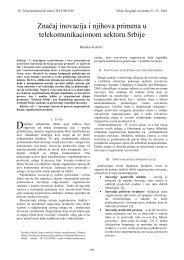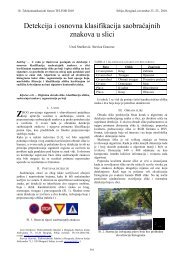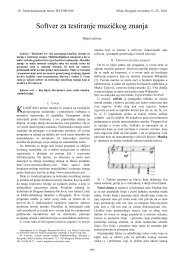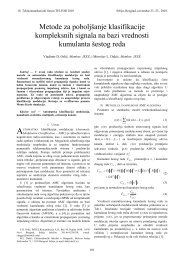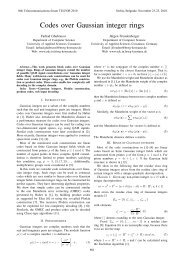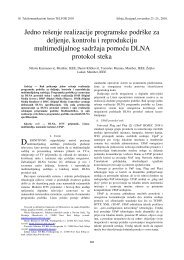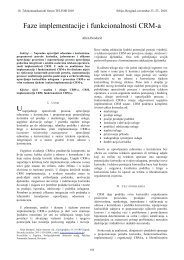Hybrid Higher Order FEM-MoM Analysis of ... - Telfor 2010
Hybrid Higher Order FEM-MoM Analysis of ... - Telfor 2010
Hybrid Higher Order FEM-MoM Analysis of ... - Telfor 2010
You also want an ePaper? Increase the reach of your titles
YUMPU automatically turns print PDFs into web optimized ePapers that Google loves.
18th Telecommunications forum TELFOR <strong>2010</strong> Serbia, Belgrade, November 23-25, <strong>2010</strong>. <br />
<br />
Abstract — A novel higher order entire-domain finite<br />
element technique is presented for accurate and efficient fullwave<br />
three-dimensional analysis <strong>of</strong> electromagnetic<br />
structures with continuously inhomogeneous material<br />
regions, using large (up to about two wavelengths on a side)<br />
generalized curved hierarchical curl-conforming hexahedral<br />
vector finite elements (<strong>of</strong> arbitrary geometrical and fieldapproximation<br />
orders) that allow continuous change <strong>of</strong><br />
medium parameters throughout their volumes. The results<br />
demonstrate considerable reductions in both number <strong>of</strong><br />
unknowns and computation time <strong>of</strong> the entire-domain <strong>FEM</strong><br />
modeling <strong>of</strong> continuously inhomogeneous materials over<br />
piecewise homogeneous models.<br />
Keywords — Computer-aided analysis, electromagnetic<br />
analysis, electromagnetic scattering, finite element method,<br />
higher order elements, inhomogeneous media, method <strong>of</strong><br />
moments.<br />
I<br />
<strong>Hybrid</strong> <strong>Higher</strong> <strong>Order</strong> <strong>FEM</strong>-<strong>MoM</strong> <strong>Analysis</strong> <strong>of</strong><br />
Continuously Inhomogeneous Electromagnetic<br />
Scatterers<br />
Milan M. Ili, Member, IEEE, Slobodan V. Savi, Andjelija Ž Ili, Member, IEEE, and<br />
Branislav M. Notaroš, Senior Member, IEEE<br />
I. INTRODUCTION<br />
N electromagnetics (EM), the finite element method<br />
(<strong>FEM</strong>) in its various forms and implementations [1]-[4]<br />
has been effectively used for quite some time in full-wave<br />
three-dimensional (3D) computations based on<br />
discretizing partial differential equations. A tremendous<br />
amount <strong>of</strong> effort has been invested in the research <strong>of</strong> the<br />
<strong>FEM</strong> technique in the past 4 decades, making <strong>FEM</strong><br />
methodologies and techniques extremely powerful and<br />
universal numerical tools for solving a broad range <strong>of</strong> both<br />
closed-region (e.g., waveguide and cavity) and openregion<br />
(e.g., antenna and scattering) problems. In the case<br />
<strong>of</strong> open-region problems, hybrid finite element-boundary<br />
integral (FE-BI) technique is used for the exact truncation<br />
<strong>of</strong> the unbounded spatial domain [5]-[6].<br />
For modeling and analyzing structures that contain<br />
This work was supported by the Serbian Ministry <strong>of</strong> Science and<br />
Technological Development under grant ET-11021 and by the National<br />
Science Foundation under grants ECCS-0647380 and ECCS-0650719.<br />
Milan M. Ili is with the School <strong>of</strong> Electrical Engineering, University<br />
<strong>of</strong> Belgrade, Bulevar kralja Aleksandra 73, 11120 Belgrade, Serbia;<br />
(phone: 381-11-3370101; e-mail: milanilic@etf.rs).<br />
Slobodan V. Savi is with the School <strong>of</strong> Electrical Engineering,<br />
University <strong>of</strong> Belgrade, Bulevar kralja Aleksandra 73, 11120 Belgrade,<br />
Serbia; (e-mail: milanilic@etf.rs).<br />
Andjelija Ž. Ili is with the Vina Institute <strong>of</strong> Nuclear Sciences,<br />
Laboratory <strong>of</strong> Physics 010, P.O. Box 522, 11001 Belgrade, Serbia;<br />
(e-mail: andjelijailic@ieee.org).<br />
Branislav M. Notaroš is with the ECE Department, Colorado State<br />
University, 1373 Campus Delivery, Fort Collins, CO 80523-1373, USA;<br />
(e-mail: notaros@colostate.edu).<br />
843<br />
inhomogeneous and complex electromagnetic materials,<br />
<strong>FEM</strong> technique is very efficient and well established as a<br />
method <strong>of</strong> choice. In almost every <strong>FEM</strong> technique, within<br />
a really abundant and impressive body <strong>of</strong> work in the<br />
field, the theory is developed and <strong>FEM</strong> equations are<br />
derived taking advantage <strong>of</strong> the inherent ability <strong>of</strong> <strong>FEM</strong> to<br />
directly treat continuously inhomogeneous materials<br />
(complex permittivity and permeability <strong>of</strong> the media can<br />
be arbitrary functions, or tensors, <strong>of</strong> spatial coordinates,<br />
e.g., (r)<br />
and (r)<br />
, with r standing for the position<br />
vector <strong>of</strong> a point in the adopted coordinate system).<br />
However, it appears that there are practically no papers on<br />
this subject, presenting technique or computer code that<br />
actually implements (r)<br />
and (r)<br />
as continuous space<br />
function within a finite element (FE), thus enabling direct<br />
computation on finite elements that include arbitrary<br />
(continuously) inhomogeneous material. Instead, <strong>FEM</strong><br />
computations are carried out on piecewise homogeneous<br />
approximate model <strong>of</strong> the inhomogeneous structure, with<br />
(r)<br />
and (r)<br />
replaced by the appropriate piecewise<br />
constant approximations. On the other hand, even from the<br />
geometrical modeling point <strong>of</strong> view, it is much simpler<br />
and faster to generate a model <strong>of</strong> the structure with a<br />
single, or few, large continuously inhomogeneous<br />
elements, than a mesh <strong>of</strong> a graded layered structure. In<br />
most <strong>of</strong> the practical situations, such an approach can<br />
dramatically reduce the time needed for an<br />
electromagnetic modeler to set up the problem and<br />
initially model the geometry, before any mesher [7] can be<br />
used to preprocess the data for analysis.<br />
Numerical modeling employing continuously<br />
inhomogeneous finite elements is expected to find<br />
practical applications in analysis <strong>of</strong> a broad range <strong>of</strong><br />
devices, systems, and phenomena in electromagnetics,<br />
including electromagnetic interaction with biological<br />
tissues and materials, absorbing coatings for reduction <strong>of</strong><br />
radar cross sections <strong>of</strong> targets, scattering and diffraction<br />
from inhomogeneous dielectric lenses used for lens<br />
antennas and related structures.<br />
For fully exploiting modeling flexibility <strong>of</strong> continuously<br />
inhomogeneous finite elements, these elements should be<br />
electrically large, which implies use <strong>of</strong> the higher order<br />
field expansions within the elements, as shown in our<br />
preliminary results in [8]. Since the fields in the low order
<strong>FEM</strong> technique are approximated by the low-order basis<br />
functions, the elements must be electrically very small (on<br />
the order <strong>of</strong> a tenth <strong>of</strong> the wavelength in each dimension).<br />
Subdivision <strong>of</strong> the structure using such elements results in<br />
a discretization <strong>of</strong> the permittivity and permeability<br />
pr<strong>of</strong>iles as well, so that elements can be treated as<br />
homogeneous, i.e. their treatment as inhomogeneous<br />
would practically have no effect on the results. Within the<br />
higher order computational approach [9], on the other<br />
hand, higher order basis functions enable the use <strong>of</strong><br />
electrically large geometrical elements (e.g., on the order<br />
<strong>of</strong> a wavelength in each dimension). We refer to the direct<br />
<strong>FEM</strong> computation on such elements as the entire-domain<br />
or large-domain analysis. Note that, in general, higher<br />
order <strong>FEM</strong> technique [10]-[14] can greatly reduce the<br />
number <strong>of</strong> unknowns for a given (homogeneous or<br />
inhomogeneous) problem and enhance the accuracy and<br />
efficiency <strong>of</strong> the analysis in comparison to the low-order<br />
solutions.<br />
II. THEORY AND NUMERICAL IMPLEMENTATION<br />
Consider an electromagnetic structure that contains<br />
some continuously inhomogeneous material regions, as<br />
shown in Fig. 1. In our analysis method, the computation<br />
domain is first tessellated using higher order geometrical<br />
elements in the form <strong>of</strong> Lagrange-type generalized curved<br />
parametric hexahedra <strong>of</strong> arbitrary geometrical orders<br />
Ku , Kv<br />
, and Kw<br />
( K u,<br />
Kv<br />
, Kw<br />
1<br />
), analytically described<br />
as [10]:<br />
r(<br />
u,<br />
v,<br />
w)<br />
<br />
L<br />
K u<br />
i<br />
K u K v K w<br />
rijk<br />
i0<br />
j0<br />
k 0<br />
( u)<br />
<br />
K<br />
u<br />
<br />
l<br />
0<br />
l<br />
i<br />
L<br />
K u<br />
i<br />
u u l<br />
,<br />
u u<br />
i<br />
l<br />
( u)<br />
L<br />
K v<br />
j<br />
( v)<br />
L<br />
K w<br />
k<br />
( w)<br />
,<br />
1 u,<br />
v,<br />
w 1,<br />
where rijk r(<br />
ui,<br />
v j,<br />
wk<br />
) are the position vectors <strong>of</strong> the<br />
interpolation nodes,<br />
Ku<br />
i<br />
(1)<br />
L represent Lagrange interpolation<br />
polynomials, and similar for L (v)<br />
v<br />
w<br />
j and L k . Equation<br />
(1) defines a mapping from a cubical parent domain to the<br />
generalized hexahedron, as illustrated in Fig. 2.<br />
O<br />
r<br />
r( r)<br />
r( r)<br />
K<br />
n inc<br />
K<br />
H inc<br />
E inc<br />
Fig. 1. Electromagnetic structure with continuously<br />
inhomogeneous material.<br />
The electric field in the element, E ( u,<br />
v,<br />
w)<br />
, is<br />
844<br />
approximated by means <strong>of</strong> curl-conforming hierarchical<br />
polynomial vector basis functions given in [10]; let us<br />
denote the functions by f ( u,<br />
v,<br />
w)<br />
, and the respective<br />
arbitrary field-approximation orders <strong>of</strong> the polynomial by<br />
Nu, , Nv<br />
, and N w ( N u,<br />
Nv<br />
, Nw<br />
1 ). The higher order<br />
hierarchical basis functions with improved orthogonality<br />
and conditioning properties constructed from Legendre<br />
polynomials [12] may also be implemented.<br />
v = 1<br />
u =1<br />
u<br />
w =1<br />
w = 1<br />
w<br />
O'<br />
u = 1<br />
x<br />
v =1<br />
z<br />
O<br />
v<br />
y<br />
v = 1<br />
u =1<br />
u = 1<br />
w =1<br />
uvw ,, )<br />
uvw ,, )<br />
r<br />
r<br />
w = 1<br />
v =1<br />
Fig. 2. Generalized curved parametric hexahedron<br />
defined by (1), with the continuous variation <strong>of</strong> medium<br />
parameters given by (2); cubical parent domain is also<br />
shown.<br />
Continuous variation <strong>of</strong> medium parameters in the<br />
computation model can be implemented in different ways.<br />
We choose to take full advantage <strong>of</strong> the already developed<br />
Lagrange interpolating scheme for defining element<br />
spatial coordinates in (1), which can be conveniently<br />
reused to govern the change <strong>of</strong> both the complex relative<br />
permittivity and permeability, r and r , within the<br />
element shown in Fig. 2, as follows:<br />
K<br />
K<br />
K<br />
u v w<br />
K u K v K w<br />
r ( u,<br />
v,<br />
w)<br />
<br />
r, ijk Li<br />
( u)<br />
L j ( v)<br />
Lk<br />
( w)<br />
, (2)<br />
i0<br />
j 0 k 0<br />
1 u,<br />
v,<br />
w 1,<br />
where r, ijk r<br />
( ui<br />
, v j , wk<br />
) are the relative permittivity<br />
values at the point defined by position vectors <strong>of</strong> spatial<br />
interpolation nodes, r ijk , and similarly for r . With such<br />
representation <strong>of</strong> material properties, we then solve for the<br />
unknown field coefficients by substituting the field<br />
expansion E ( u,<br />
v,<br />
w)<br />
in the curl-curl electric-field vector<br />
wave equation [10], reading:<br />
1<br />
r ( u,<br />
v,<br />
w)<br />
E ( u,<br />
v,<br />
w)<br />
(3)<br />
2<br />
k0<br />
r ( u,<br />
v,<br />
w)<br />
E(<br />
u,<br />
v,<br />
w)<br />
0,<br />
where k 0 00<br />
stands for the free-space wave<br />
number. A standard Galerkin weak-form discretization <strong>of</strong><br />
(3) yields:<br />
<br />
V<br />
<br />
1<br />
r<br />
k<br />
( u,<br />
v,<br />
w)<br />
[ f ( u,<br />
v,<br />
w)]<br />
[<br />
E(<br />
u,<br />
v,<br />
w)]<br />
dV<br />
2<br />
0<br />
<br />
V<br />
<br />
( u,<br />
v,<br />
w)<br />
f ( u,<br />
v,<br />
w)<br />
E(<br />
u,<br />
v,<br />
w)<br />
dV<br />
r<br />
<br />
S<br />
<br />
1<br />
r<br />
t<br />
t<br />
( u,<br />
v,<br />
w)<br />
f ( u,<br />
v,<br />
w)<br />
n [<br />
E(<br />
u,<br />
v,<br />
w)]<br />
dS<br />
,<br />
t<br />
(4)
where V is the volume <strong>of</strong> the element, bounded by the<br />
surface S, n is the outward unit normal on S, and f t are<br />
the testing functions (the same as the basis functions).<br />
Once the field coefficients are found, all quantities <strong>of</strong><br />
interest for the analysis are obtained in a straightforward<br />
manner.<br />
III. RESULTS AND DISCUSSION<br />
As an example <strong>of</strong> entire-domain <strong>FEM</strong> analysis <strong>of</strong> an<br />
open-region continuously inhomogeneous structure,<br />
consider a lossless cubical dielectric ( r 1)<br />
scatterer, <strong>of</strong><br />
the side length 2a, and a linear variation <strong>of</strong> r from r<br />
1<br />
at the surface to r 6 at the center <strong>of</strong> the cube, as shown<br />
in Fig. 3. The scatterer is situated in free space and<br />
illuminated by a uniform plane wave incident normal to<br />
one face <strong>of</strong> the scatterer, as shown. The <strong>FEM</strong> domain is<br />
truncated at the cube faces by means <strong>of</strong> unknown electric<br />
and magnetic surface currents <strong>of</strong> densities J S and J mS ,<br />
respectively, that are evaluated by the <strong>MoM</strong>/SIE, giving<br />
rise to a hybrid higher order <strong>FEM</strong>-<strong>MoM</strong> solution [6].<br />
2a<br />
o o<br />
2a<br />
<strong>FEM</strong><br />
r<br />
6<br />
1<br />
O<br />
2a<br />
J , J S mS<br />
y<br />
x<br />
n inc<br />
<strong>MoM</strong><br />
H inc<br />
Fig. 3. <strong>FEM</strong>-<strong>MoM</strong> analysis <strong>of</strong> a lossless continuously<br />
inhomogeneous cubical dielectric scatterer. Single-element<br />
<strong>FEM</strong> domain with linear variation <strong>of</strong> permittivity.<br />
To represent this permittivity variation using the<br />
expansions in (2), the cube is modeled by 7 trilinear<br />
hexahedral finite elements <strong>of</strong> the first geometrical order.<br />
a<br />
Namely, one small cube-like hexahedral, in length, is<br />
10<br />
situated at the cube center and surrounded by 6 “cushion”like<br />
hexahedra between the central cube and the scatterer<br />
surface, onto witch 6 bilinear quadrilateral <strong>MoM</strong> patches<br />
are attached. The obtained model <strong>of</strong> the scatterer is shown<br />
in Fig. 4. The field/current approximation orders are 5 in<br />
all directions for all FE “cushions” and 4 in all directions<br />
for the central finite element and all <strong>MoM</strong> patches,<br />
resulting in 2560 <strong>FEM</strong> and 354 <strong>MoM</strong> unknowns, and a<br />
total <strong>of</strong> 339 s <strong>of</strong> simulation time for 35 frequencies.<br />
E inc<br />
<strong>MoM</strong><br />
patches<br />
o o<br />
a/10<br />
5.875<br />
5.75<br />
1<br />
0<br />
2a<br />
r<br />
<strong>FEM</strong><br />
elements<br />
x<br />
<strong>MoM</strong><br />
patches<br />
Fig. 4. Model <strong>of</strong> a lossless, continuously<br />
inhomogeneous cubical dielectric scatterer consisting <strong>of</strong> 7<br />
finite elements and 6 quadrilateral <strong>MoM</strong> patches.<br />
To both validate the continuously inhomogeneous<br />
<strong>FEM</strong>-<strong>MoM</strong> model <strong>of</strong> the scatterer and evaluate its<br />
efficiency against the piecewise homogeneous<br />
approximate model, the scattering results <strong>of</strong> the higher<br />
order <strong>FEM</strong>-<strong>MoM</strong> analysis using large finite elements with<br />
continuously changing r are compared with the solution<br />
obtained by higher order <strong>FEM</strong>-<strong>MoM</strong> simulations <strong>of</strong><br />
piecewise homogeneous approximate model <strong>of</strong> the<br />
structure in Fig. 4. Each <strong>of</strong> the 6 “cushions” <strong>of</strong> the<br />
continuous model are replaced, respectively by,<br />
Nl 2,<br />
3,<br />
4,<br />
and 7 homogeneous thin “cushions” (platelike<br />
layers), approximating the continuously<br />
inhomogeneous pr<strong>of</strong>ile, which is illustrate in Fig. 5<br />
for N l 4 . Each plate-like layer in layered models is<br />
represented by 6 finite elements <strong>of</strong> the first geometrical<br />
order. Field-approximation orders in these elements are 2<br />
in the radial direction and 5 in transversal directions.<br />
r<br />
845<br />
6.0<br />
5.5<br />
5.0<br />
4.5<br />
4.0<br />
3.5<br />
3.0<br />
2.5<br />
2.0<br />
r continuous<br />
r piecewise constant<br />
approximation<br />
Fig. 5. Piecewise homogeneous approximate graded model<br />
( N l 4 ) <strong>of</strong> the structure in Fig. 3, and piecewise constant<br />
approximation <strong>of</strong> relative permittivity pr<strong>of</strong>iles.<br />
Shown in Fig. 6 is the normalized (to 2<br />
0 ) monostatic<br />
radar cross section (RCS) <strong>of</strong> the cube (as a function <strong>of</strong><br />
/ being the free space wavelength. We observe<br />
a 0 ), 0<br />
2a<br />
5.875<br />
O<br />
5.156<br />
3.969<br />
2.781<br />
x<br />
1.5<br />
1.0<br />
1.594<br />
r<br />
0.0 0.1 0.2 0.3 0.4 0.5<br />
x/a<br />
0.6 0.7 0.8 0.9 1.0
a very good convergence <strong>of</strong> the results obtained by the<br />
layered <strong>FEM</strong>-<strong>MoM</strong> technique to those for the continuous<br />
<strong>FEM</strong>-<strong>MoM</strong> model, as N l increases, as well as an<br />
excellent agreement between the 7-layer and continuous<br />
<strong>FEM</strong>-<strong>MoM</strong> solution. Theoretically, only an infinite<br />
number <strong>of</strong> layers would give the exact solution to the<br />
problem in Fig. 3.<br />
As an additional verification <strong>of</strong> the analysis, the higher<br />
order <strong>MoM</strong> technique based on the surface integral<br />
equation (SIE), i.e. <strong>MoM</strong>/SIE technique [14], is used to<br />
obtain a reference solution for the 7-layer model. An<br />
excellent agreement <strong>of</strong> the higher order <strong>MoM</strong>/SIE and the<br />
corresponding <strong>FEM</strong>-<strong>MoM</strong> results, for the 7-layer model,<br />
is observed.<br />
The additional data shown in the legend <strong>of</strong> Fig. 6 gives<br />
a comparison <strong>of</strong> the number <strong>of</strong> unknowns used and the<br />
computation time for all 6 models. We conclude from the<br />
data shown that the continuous material model is<br />
substantially more efficient than the layered analysis. It is<br />
34.16 times faster than the most accurate layered solution<br />
(for N l 7 ), and the total number <strong>of</strong> unknowns is<br />
reduced 5.6 times.<br />
2<br />
RCS/ 0<br />
2.0<br />
1.8<br />
1.6<br />
1.4<br />
1.2<br />
1.0<br />
0.8<br />
0.6<br />
0.4<br />
0.2<br />
Unknowns Time[s]<br />
Continuosu <strong>FEM</strong>-<strong>MoM</strong><br />
2560-384 339.1<br />
Layered <strong>FEM</strong>-<strong>MoM</strong><br />
2 layers 4820-384 1420.6<br />
3 layers 7080-384 3398.9<br />
4 layers 9340-384 4941.2<br />
7 layers 16120-384 11584.9<br />
Layered <strong>MoM</strong> (Reference)<br />
7 layers 2688 1125.0<br />
0.0<br />
0.05 0.10 0.15 0.20 0.25 0.30 0.35 0.40 0.45 0.50 0.55<br />
a/ 0<br />
Fig. 6. Normalized monostatic radar cross section <strong>of</strong> the<br />
cubical scatterer in Fig. 3 (0 is the free-space<br />
wavelength). Results using the continuous <strong>FEM</strong>-<strong>MoM</strong>,<br />
four different layered <strong>FEM</strong>-<strong>MoM</strong> models, and reference<br />
<strong>MoM</strong>/SIE model are compared.<br />
All numerical results are obtained using HP EliteBook<br />
8440p notebook computer with Intel i5-540 CPU running<br />
at 2.53 GHz and with 2 GB <strong>of</strong> RAM under Micros<strong>of</strong>t<br />
Windows 7 operating system.<br />
IV. CONCLUSION<br />
A novel higher order entire domain hybrid <strong>FEM</strong>-<strong>MoM</strong><br />
technique for accurate and efficient full-wave 3D EM<br />
analysis using large (up to two wavelengths on a side)<br />
finite elements that allow continuous change <strong>of</strong> medium<br />
parameters throughout their volumes, has been presented.<br />
Lagrange-type generalized curved parametric hexahedra<br />
<strong>of</strong> arbitrary geometrical orders with the curl-conforming<br />
846<br />
hierarchical polynomial vector basis functions <strong>of</strong> arbitrary<br />
field-approximation orders and Lagrange interpolation<br />
scheme for variations <strong>of</strong> medium parameters have been<br />
used.<br />
The validity, accuracy, and efficiency <strong>of</strong> the new<br />
technique have been demonstrated through an example <strong>of</strong><br />
EM scatterer with linearly varying permittivity <strong>of</strong> the<br />
dielectric. The example has shown that effective higher<br />
order <strong>FEM</strong> hexahedral meshes, constructed from a very<br />
small number <strong>of</strong> large finite elements with p-refined field<br />
distributions <strong>of</strong> high approximation orders, is the method<br />
<strong>of</strong> choice for EM modeling <strong>of</strong> structures including<br />
material inhomogeneities. High efficiency, and<br />
considerable reductions in both number <strong>of</strong> unknowns and<br />
computation time <strong>of</strong> the entire-domain <strong>FEM</strong> modeling <strong>of</strong><br />
continuously inhomogeneous material, in comparison with<br />
the piecewise homogeneous (layered) models, have been<br />
demonstrated.<br />
[1]<br />
REFERENCES<br />
P. P. Silvester and R. L. Ferrari, Finite Elements for Electrical<br />
Engineers, 3rd ed., Cambridge University Press, 1996.<br />
[2] J. M. Jin, The Finite Element Method in Electromagnetics, 2nd ed.,<br />
John Wiley & Sons, New York, 2002.<br />
[3] J. L. Volakis, A. Chatterjee, and L. C. Kempel, “Finite Element<br />
Method for Electromagnetics”, IEEE Press, New York, 1998.<br />
[4] J. L. Volakis, K. Sertel, and B. C. Usner, Frequency Domain<br />
<strong>Hybrid</strong> Finite Element Methods in Electromagnetics, Morgan &<br />
Claypool Publishers, 2006.<br />
[5] J.-M. Jin, J. L. Volakis, and J. D. Collins, “A finite-elementboundary-integral<br />
method for scattering and radiation by two- and<br />
three-dimensional structures”, IEEE Antennas and Propagation<br />
Magazine, Vol. 33, pp. 22-32, March 1991.<br />
[6] M. M. Ili, M. Djordjevi, A. Ž. Ili, and B. M. Notaroš, “<strong>Higher</strong><br />
<strong>Order</strong> <strong>Hybrid</strong> <strong>FEM</strong>-<strong>MoM</strong> Technique for <strong>Analysis</strong> <strong>of</strong> Antennas and<br />
Scatterers”, IEEE Transactions on Antennas and Propagation,<br />
August 2008.<br />
[7] S. V. Savi, M. M. Ili, B. M. Kolundžija, and B. M. Notaroš,<br />
“Efficient Modeling <strong>of</strong> Complex Electromagnetic Structures Based<br />
on the Novel Algorithm for Spatial Segmentation Using Hexahedral<br />
Finite Elements”, submitted for <strong>Telfor</strong> Journal, <strong>2010</strong>.<br />
[8] M. M. Ili, A. Ž. Ili, and B. M. Notaroš, “Continuously<br />
Inhomogeneous <strong>Higher</strong> <strong>Order</strong> Finite Elements for 3-D<br />
[9]<br />
Electromagnetic <strong>Analysis</strong>”, IEEE Transaction on Antennas and<br />
Propagation, Vol. 57, No. 9, pp. 2798-2802, September 2009.<br />
B. M. Notaroš, “<strong>Higher</strong> <strong>Order</strong> Frequency-Domain Computational<br />
Electromagnetics”, Special Issue on Large and Multiscale<br />
Computational Electromagnetics, IEEE Transactions on Antennas<br />
and Propagation, Vol. 56, No. 8, pp. 2251-2276, August 2008.<br />
[10] M. M. Ili and B. M. Notaroš, “<strong>Higher</strong> order hierarchical curved<br />
hexahedral vector finite elements for electromagnetic modeling”,<br />
IEEE Transactions on Microwave Theory and Techniques, Vol. 51,<br />
No. 3, pp. 1026-1033, March 2003.<br />
[11] M. M. Ili, A. Ž. Ili, and B. M. Notaroš, “<strong>Higher</strong> order<br />
large-domain <strong>FEM</strong> modeling <strong>of</strong> 3-D multiport waveguide structures<br />
with arbitrary discontinuities”, IEEE Transactions on Microwave<br />
Theory and Techniques, Vol. 52, No. 6, pp. 1608-1614, June 2004.<br />
[12] M. M. Ili and B. M. Notaroš, “<strong>Higher</strong> order large-domain<br />
hierarchical <strong>FEM</strong> technique for electromagnetic modeling using<br />
Legendre basis functions on generalized hexahedra",<br />
Electromagnetics, Vol. 26, pp. 517-529, October 2006.<br />
[13] A. Ž. Ili, S. V. Savi, M. M. Ili, and B. M. Notaroš, “<strong>Analysis</strong> <strong>of</strong><br />
Electromagnetic Scatterers Using <strong>Hybrid</strong> <strong>Higher</strong> <strong>Order</strong> <strong>FEM</strong>-<strong>MoM</strong><br />
Technique”, <strong>Telfor</strong> Journal, Vol. 1, No. 2, pp. 53-56, 2009.<br />
[14] B. M. Kolundžija, J. S. Ognjanovi, T. K. Sarkar, D. S. Šumi, M.<br />
M. Paramenti, B. B. Jani, D. I. Olan, D. V. Toši, M. S. Tasi,<br />
WIPL-D Microwave: Circuits and 3D EM Simulation <strong>of</strong> RF &<br />
Microwave Applications, WIPL-D & Artech House, 2005.



